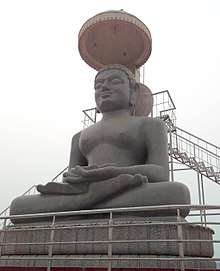Jambuswami
Jambuswami (543-449 BCE) was the spiritual successor of Sudharmaswami in Jain religious order reorganised by Mahavira.[1][2] He remained the head for 39 or 44 years, after which he is believed to have gained Kevala Jnana (omniscience).[1][3] He is believed to be the third and last kevali (omniscient being) after Mahavira in Jain tradition.[4] He is believed to have attained moksha (liberated) at the age of 80 in Mathura.[1][3]
| Jambuswami | |
|---|---|
 18-foot-tall sculpture of Jambuswami at Mathura Chaurasi |
| Part of a series on |
| Jainism |
|---|
 |
|
Jain prayers |
|
Ethics |
|
Major sects |
|
Texts |
|
Festivals
|
|
|
Jambu was succeeded by Prabhava (443-338 BCE), who was converted from a bandit by him on Jambu's wedding night.[2] Prabhava was succeeded by Shayyambhava (377-315 BCE), a converted Vedic sholar.[2] Shayyambhava composed Dasavaikalika sutra after studying the fourteen purvas (pre-canonical texts).[2] He was initated as a Jain monk when his wife was pregnant with Manaka.[5] He initiated his son as a monk at the age of eight and taught him sacred knoledge in 10 lectures in six months after which the latter died.[6]
Shayyambhava was succeeded by Yasobhadra (351-235 BCE), who was succeeded by his two disciples, Sambhutavijaya (347-257 BCE) and Bhadrabahu (322-243 BCE).[6]
References
Citations
- Natubhai Shah 2004, p. 39.
- Natubhai Shah 2004, p. 41.
- Pramansagar 2014, p. 46.
- Kshamasagar 2009, p. 132.
- Natubhai Shah 2004, pp. 41-42.
- Natubhai Shah 2004, p. 42.
Sources
- Kshamasagar (2009), jain darshan, Maitreesamoh, ISBN 81-7628-017-8
- Pramansagar (2014), jain dharma aur darshan, Nirgranth Foundation, ISBN 81-7483-007-3
- Shah, Natubhai (2004) [First published in 1998], Jainism: The World of Conquerors, I, Motilal Banarsidass, ISBN 978-81-208-1938-2